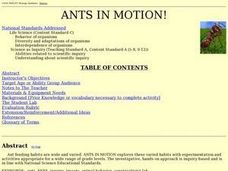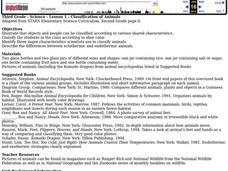Curated OER
Into the Bat Cave
Students explore the lives of bats. In this bat lesson plan, students participate in up 6 activities that focus on bats and build their background knowledge about the nocturnal mammals.
PBS
The Caterpillar or Larva
The larval stage of the butterfly life cycle is quite exciting. Start a discussion about the specially designed body parts unique to caterpillars. After examining images of caterpillars, learners use plastic soda bottles, string, and...
Curated OER
Learning About Animals' Bodies
Students research different animals (mammals, reptiles, amphibians, insects, birds, fish) and create books, murals, dioramas, puppets, and sculptures to illustrate the necessity of various body parts for overall survival. In this animal...
Curated OER
The Listening Walk
Students play instruments that reflect sounds in the story: hoots, toots, creaking, shrieks, clacking, crunching, whooshing, etc. They make vocal sounds from the story: whispered, sniffled, sigh, giggled, croaked, laughed. The...
Curated OER
Ladybugs
For this ladybug life style worksheet, students match 7 body parts to a diagram of a ladybug and draw the 4 different stages of a ladybug's life cycle.
Curated OER
Araceli Solis Butterflies Unit
Third graders study the life cycle, eating habits, habitats, and migration patterns of butterflies in this series of lessons.
Curated OER
Life Cycle
Third graders examine and compare the life cycles of a variety of different animals. They analyze photos of animals and discuss any unique body parts and why those parts function they way they do. Next, they observe mealworms and...
Curated OER
Termitology
Students engage in an inquiry-based study of the ecology of termites. Through hands-on investigations, they explore the life cycle of termites, the termite's role in the food web, and the unique social structure of termite colonies.
Curated OER
Water and Ice
Students study the water cycle and states of matter. In this water cycle lesson, students observe ice for a period of time and record their observations. Students create a Venn Diagram comparing water in solid form and liquid form....
Curated OER
The Ant Attack
Third graders observe the daily activity of an ant farm. Through observations and journal writing, they gather data concerning the daily activities of the ants. Students use their observations to predict the effect of environmental...
Curated OER
Ants In Motion
Students brainstorm ants and their characteristics in a class discussion. They observe the ants and answer question pertaining to their behavior; then they apply the scientific method in creating and investigating a problem.
Curated OER
The Effects of Water Quality on the Growth Rate of Freshwater Mussels
Students participate in a field and laboratory study to determine if local freshwater mussels are environmentally stressed.
Curated OER
Classification of Animals
Third graders practice classiyfying items and identify three major characteristics scientists use to classify animals. They describe the differences between ectothermic and endothermic animals.
Curated OER
Plant Reproduction
Students identify the different parts and function of a flower's reproductive system. In this biology instructional activity, students explain how pollination works. They watch a video and practice labeling parts of both flower and leaf.
Curated OER
Mutualism and Co-evolution A study of Flowering Plants and their Pollinators: Biology, Plants
These lessons use a variety of methods and approaches to teach flowering plant biology which includes seed germination; plant growth and food production through photosynthesis; plant transpiration and respiration; sexual reproduction...
CK-12 Foundation
Ck 12: Life Science: Insect Food
[Free Registration/Login may be required to access all resource tools.] Insects have different types of appendages adapted for capturing and feeding on prey. They also have special senses that help them detect prey. Furthermore, insects...
Middle School Science
Middle School science.com: Perch Dissection
In this lab experiment site, you will observe the external and internal anatomy of a perch, determine the sex of a perch using internal anatomy, and collect statistical data on perch length.
Middle School Science
Middle School Science Lesson Plans: Grasshopper Lab
In this lab experiment, you will observe the external anatomy of a grasshopper, determine the sex of a grasshopper using external anatomy, and collect statistical data on grasshopper length. You will also be asked to describe the...
Scholastic
Scholastic: Science Explorations: Uncover Lizards and Snakes
An exploration of squamates, or scaled reptiles. Take notes about lizards and snakes using the pdf "Squamate Chart" while viewing a slideshow, investigate the squamate anatomy and how squamates differ from other animals, such as insects...
National Pest Managment Association
Pest World for Kids: Bug Builder
Create an ant, a bee, a spider, a cockroach, or a bug of your own design. Use the camera feature to save it to a gallery, and even email it to yourself.
Curated OER
Science Kids: Science Images: Mosquito Anatomy Diagram
This mosquito anatomy diagram labels the different parts of the mosquito, a common insect found around the world. The labeled parts include the abdomen, thorax, head, wings, legs, proboscis, antennae, and more.




















